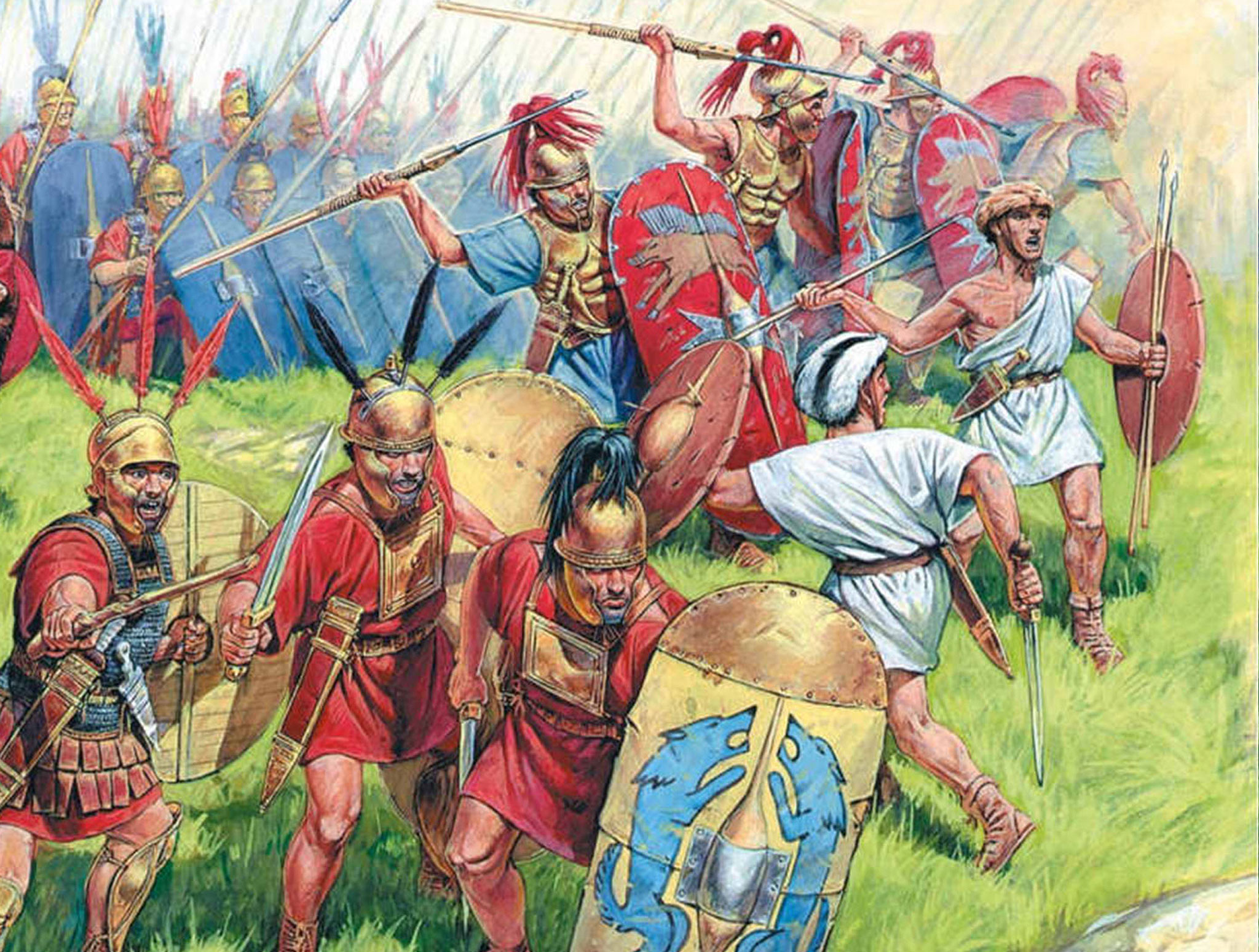
A Roman Battle Scene
Artist unknown. English Heritage, Kenilworth Castle


PROLOGUE: 
The Invasion of the Barbarians by Ulpiano Checa, 1887
Barbari ad portam!
That should have been the alarm call that July evening when foreign horsemen first came thundering down off the Pincian Hill north of Rome. It would have been the call, had there been any sentries on duty. These barbarians – Gauls, bearded and long-haired, half-naked in the summer heat, with fresh human heads dangling from the necks of their sweating horses – were astonished to find the Colline Gate, the city's northernmost, not only unguarded but wide open. A messenger was sent back to alert the bulk of the army, marching behind them. “The horsemen, who had ridden on ahead,” recorded the Roman historian Titus Livius, known to posterity as Livy, “reported that the gates were open, there were no sentries on watch, no garrison on the walls.” 
Gallic warriors, 3rd – 2nd Century ʙᴄ, by Angus McBride This was too good to be true. The Gaulish chieftain Brennus, “Raven,” was fresh off the greatest victory in the history of his people, and one of the greatest defeats of the Romans ever, certainly the greatest to that point. Now their proud city lay as helpless as a slave girl, to do with as the conquerors wished. Even “uncivilized” barbarians would have known better. Over 360 years from the founding of the city as a cluster of mud and thatch huts huddling around a ford on the River Tiber, Rome was still a Mediterranean backwater. The center of the world was 2,500 miles to the east: the Persian Empire, then the world's greatest, stretching from the Balkans to India. What would come to be known as Classical Greece was still a collection of fractious city-states – Sparta, Athens, Corinth, Thebes, Argos – quarreling over the Aegean like cats in a bag. Alexander the Great would not be born for another three decades. However, the Romans had already overthrown their Etruscan overlords and were asserting themselves over the Italian peninsula. Its northern third was still Celtic, what the Romans called Cisalpine Gaul, “Gaul this side of the Alps.” Writing some century and a half later, the Greek historian Polybius still had a low, probably stereotypical opinion of Gauls, who doubtless had changed little in the interim: They lived in open villages, without any unnecessary furnishing, for since they slept on beds of leaves and ate meat and were mainly occupied with war and farming, their lives were uncomplicated, and they had no understanding of art or science. Their only property was cattle and gold, because these were the only goods they could take with them anywhere they chose. They treated comrades as of the most importance, the most respected and powerful among them being those with the largest number of friends and followers. 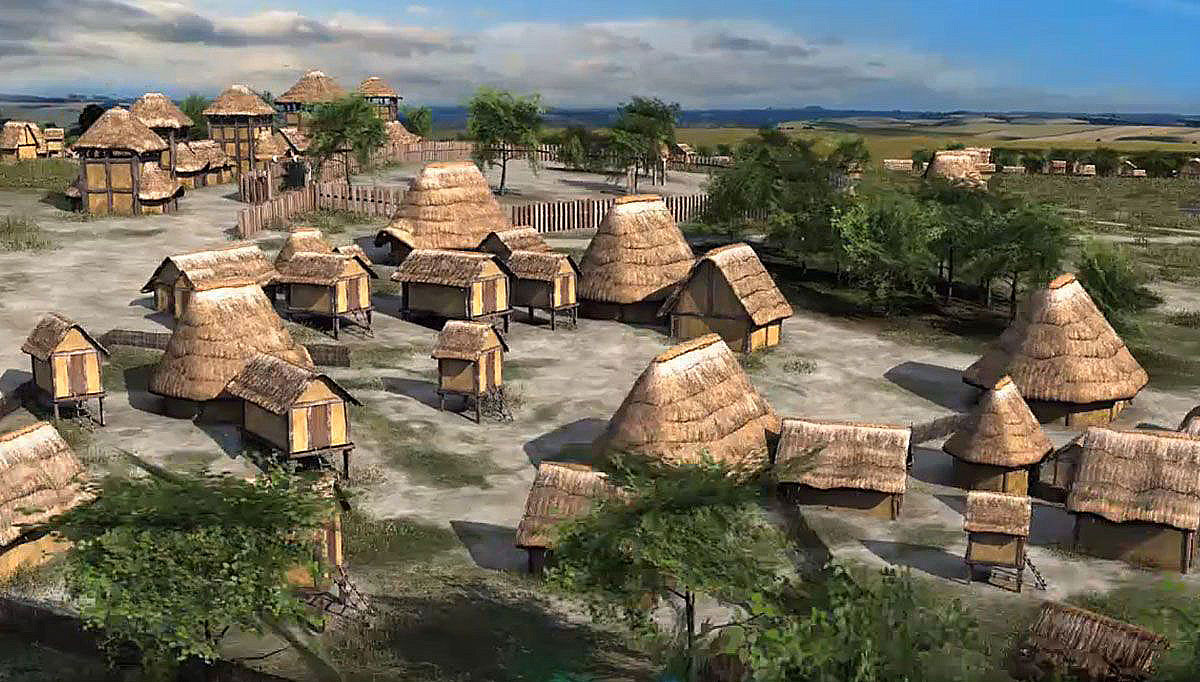
Acy-Romance, a Gallic village near modern Reims, France. 
About ten years earlier a Gaulish tribe, the Senones, had come over the Alps and descended into Italy, driving everyone before them. When finally they threatened the Etruscan town of Clusium in the borderland of Tuscany, the Romans sent brothers from the patrician family of Fabia as envoys. They found the Gauls to be crude statesmen. “The Gauls look terrifying and their voices are deep and raucous,” recorded the Greek historian Diodorus of Sicily, noting that they were men of few words, and those words mostly deceiving, boasting, or insulting. “And yet they are clever and are quick to learn.” They were unimpressed by the reputations of the Romans, but deigned to negotiate with them as protectors and representatives of the Clusines. The conditions for peace, as dictated by the Gauls, were simple: they demanded the Clusines’ land, or war. “On any other terms there will be no peace,” recorded Livy. “We will hear their answer in your presence, and if they refuse us territory we will fight while you are still here, so you may tell those at home how much braver than other men are the Gauls.” The Fabian brothers were not much better negotiators. They questioned by what right barbarians could demand territory from its proper owners. “The entire tribe which is now called both ‘Gallic’ and ‘Galatic' is mad for war, and both happy and eager for battle,” wrote the 1st-century traveler and historian, Strabo, “…annoy them when, where, or with whatever excuse you please, and you find them ready to gamble their lives, with nothing to aid them in the fight but strength and audacity.” The Gauls’ answer to the Fabians was that they took what they wanted by right of their swords. Fortune favored the brave. “Blood ran hot on both sides,” wrote Livy, “they took up arms and fell to battle.” The Roman envoys not only took part in the fighting – a breach of neutrality – one of the Fabians ran a spear through the Gaulish chieftain and was even seen defiling the body. This was murder. The barbarians forgot all about Clusium and withdrew to nurse a new hatred for Rome. Against such a vaunted state, though, tribal elders advised caution. Fresh envoys were sent to the city to demand the Fabians be handed over for justice. The senators made sympathetic noises but put the issue to the Roman people, who demonstrated their regard for Gallic ultimatums by voting the murderer and his brothers into high office, as tribunes. This taste of civilization sent the barbarians home, vowing war. “Seething with anger – as a tribe they cannot control their emotions,” wrote Livy, “they raised their flags and promptly set out on the march.” Recognizing that speeches and votes and popular opinion were ineffective and even detrimental in times of conflict, the Romans had often ceded their democratic rights in favor of a temporary dictator to carry the fight against fellow Italians. However, they had exiled their most recent, the extremely successful general Marcus Furius Camillus, under charges of embezzlement, and they did not recall him now. Against barbarians they evidently felt no dedicated war commander was necessary. They were wrong. 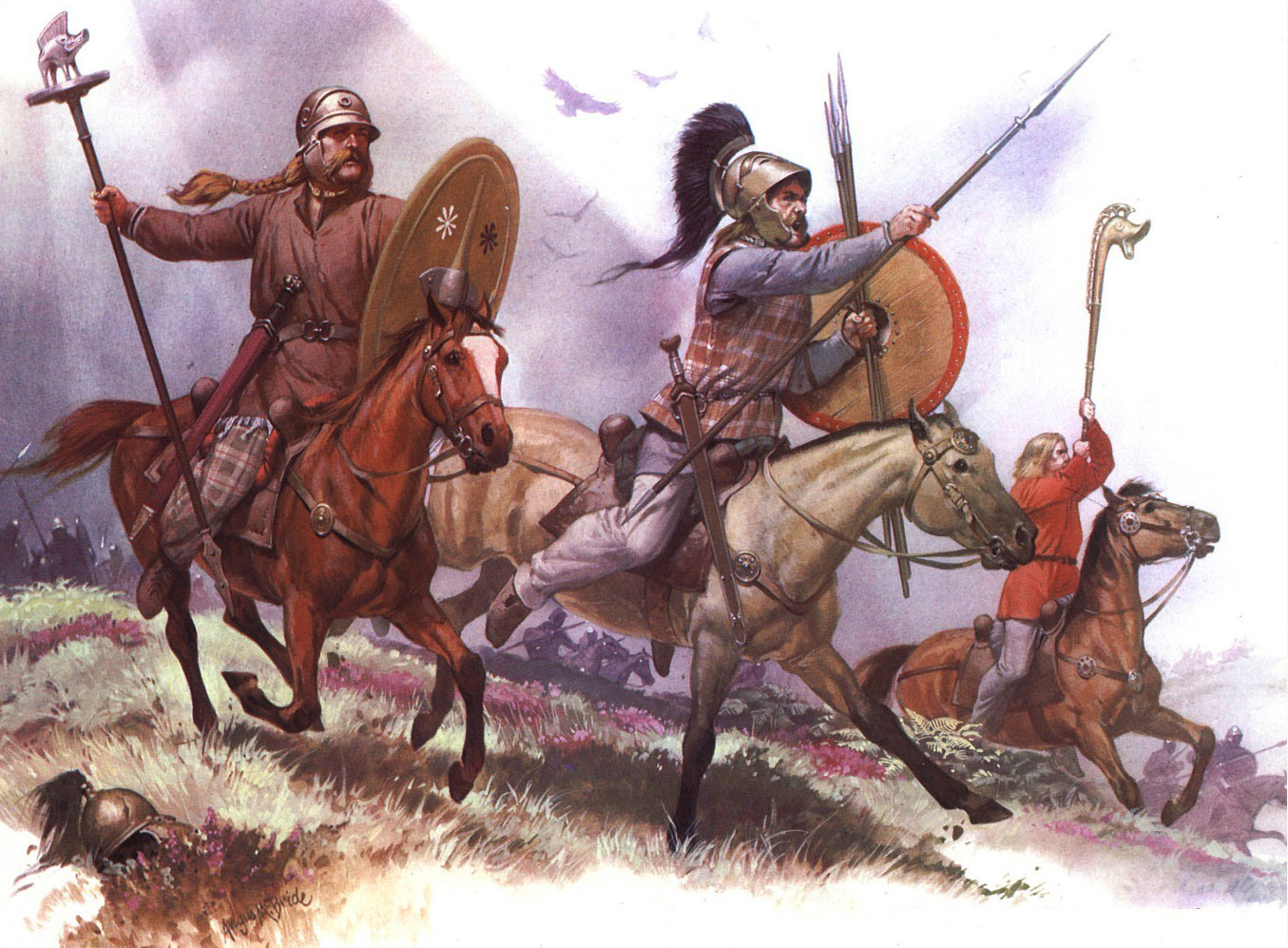
Gallic cavalry, by Angus McBride The speed with which the Gauls came rumbling down through Italy took the Romans by complete surprise. “As they thundered past, the fearful cities gathered their weapons and the country folk fled,” wrote Livy. “Horses and men, far and wide, covered a vast expanse of the land, and wherever they went they made it plain by shouting loudly that they were headed for Rome.” By the time the Romans had assembled something of an army, the barbarians were just eleven miles north of the city, where the Allia River, really no more than a brook, angled into the Tiber. On the little tongue of land between the waterways the Romans made their stand, their center stretched thin between their reserves, the left flank on the banks of the Tiber and the right on the far side of the stream, holding a small hillock. Estimation of numbers in this battle vary widely. The ancients, as was their wont, cited epic throngs – 40,000 per side, according to Plutarch – but modern estimates run as low as 12,000 each. The Romans, used to bullying the neighboring city-states, still fought in the manner of the Greeks and Etruscans, with bronze-armored hoplites relying mainly on the spear, maneuvering in ponderous phalanx formations – rigid, regimented, systematized, standardized. In a word, civilized. The Gauls had no use for that, nor for elaborate stratagems and tactics. Combat, for them, was not about discipline and teamwork. It was about prowess as a man. Units organized not into spearmen, horsemen, and swordsmen, but around friends and relatives. Leaders. Chieftains strode out between the lines to bellow insults at the enemy and boast of their own valor. All roared at the top of their lungs, clashing swords on shields, pounding drums and blaring their tall bronze war horns overhead. 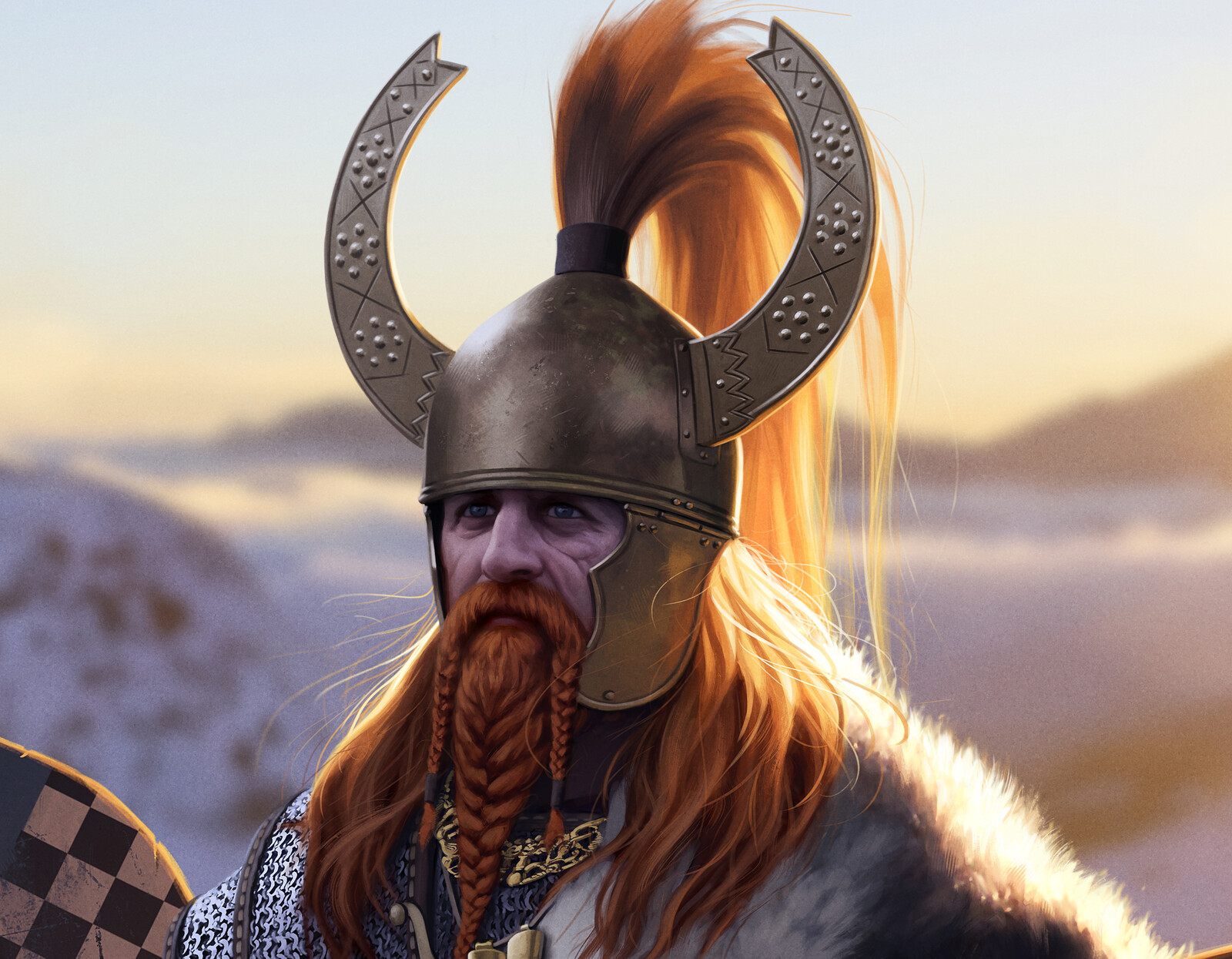
Brennus, by J.F. Oliveras Barbarian or not, however, Brennus took one look at the Roman line and knew better than to launch his army at the enemy center and let those wings sweep around behind him. He preferred instead to drive the enemy flanks off the hill and into the river, thereby surrounding their center. According to Diodorus, “the enemy outflanking the Romans, their strongest and most capable troops (whether by design or by chance is unknown) faced those weaker and untrained soldiers on the heights.” The Romans had never been on the receiving end of a barbarian charge. The sight of these screaming half-naked savages waving their heavy Celtic broadswords unnerved them. Horsemen would have been warded off by the Romans’ hedge of spears, but the Gauls simply batted the points aside and in the next instant began hacking away. 
The Battle of the Allia 
“The armies came together with a great shout,” recorded Diodorus, “and the Gauls attacking those upon the hills soon cleared the heights of them, who retreated in great disorder into their own men down on the plain, so that by fleeing under the hot pursuit by the Gauls, they broke their own ranks, and set them to running as well.” 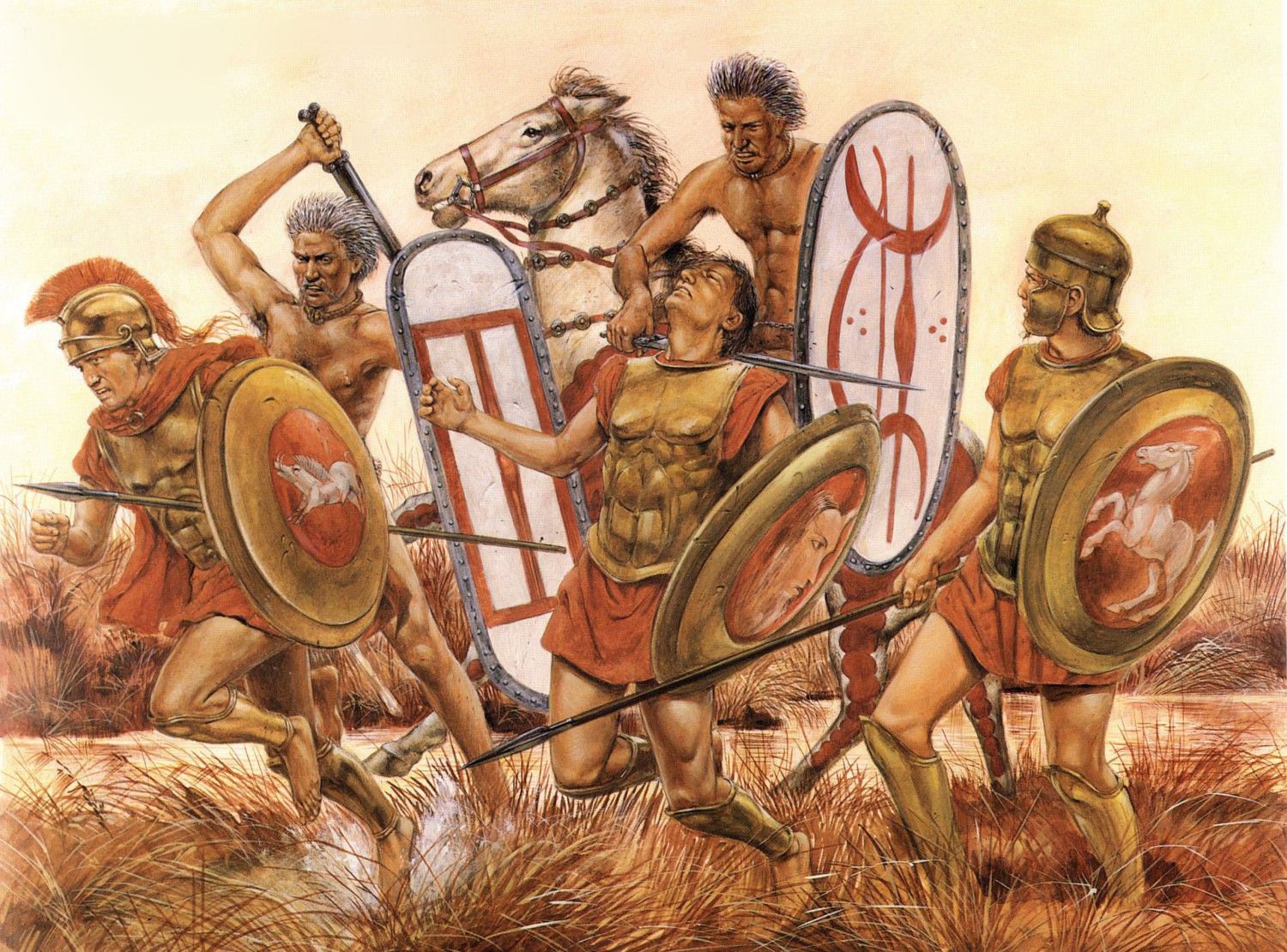
Roman hoplites flee before Celtic warriors The Roman left wing was likewise driven into the Tiber, where many drowned under the weight of their armor. The center, outflanked, was enclosed and swiftly, utterly destroyed. “The barbarians overran them,” summed up Plutarch, “and after a confused and disgraceful struggle, routed them.” “None were slain in actual combat,” sneered Livy, “but were cut down from behind while impeding one another's retreat in a tangled, struggling horde.” For centuries July 18, the day of the Battle of the Allia, would be considered by Romans to be unlucky. The Gauls themselves were surprised by the ease of victory. They suspected a ruse but, when no counterattack came, they piled the enemy weapons in heaps in an offering to their gods, as was their way. Then they set off for Rome. 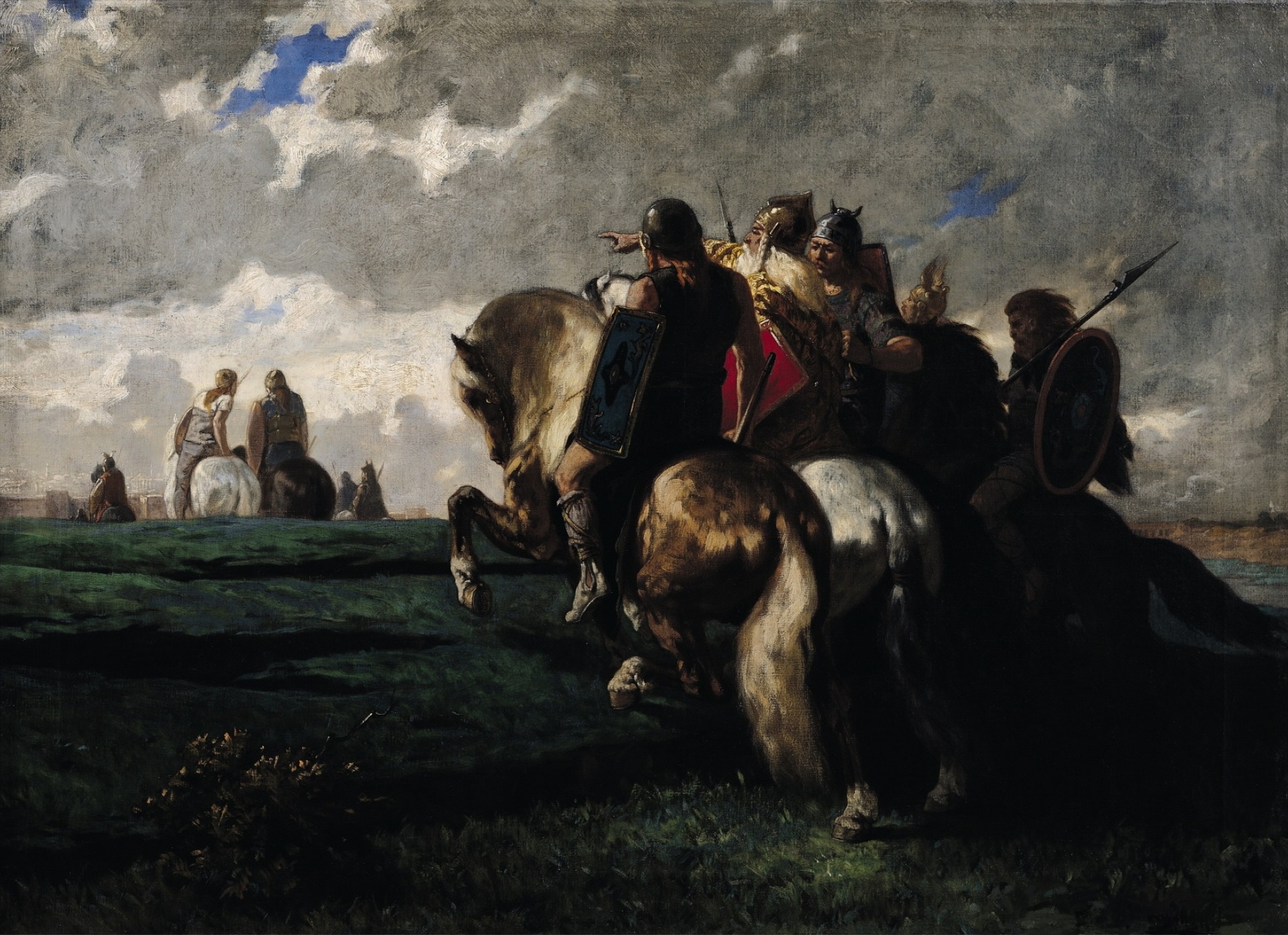
The Barbarians Before Rome, by Évariste Vital Luminais Brennus, on arrival at dusk, was no less amazed to find the city wide open to attack. Wary of a trap, hesitant to ride into a maze of unknown streets in the dark, the Gauls pitched camp outside, between the walls and the Aniene River, which today cuts through the north part of Rome before reaching the Tiber. Scout parties rode out to circle the city, whooping and yelling to terrorize everyone inside. “But all during that night and the next day,” wrote Livy, “the citizens stood in stark contrast to those who had fled in such terror at the Allia.” 
Map of Archaic Rome, looking south. Gauls arrived at the Colline Gate in lower left. At this point the city walls, which Livy mistakenly attributed to the sixth Roman King, Servius Tullius (reigned 578–535 ʙᴄ) had not yet been built. The actual “Servian Wall” was probably an earthen bank, fronted by a ditch and possibly topped with a stockade protecting the city’s most vulnerable areas. An agger, a massive earth rampart, was added in the mid-5th century ʙᴄ. Now lacking the manpower to defend the entire city, the Romans had decided to pull back within and defend only the Arx Capitolina, the citadel on the northern crest of the Capitoline Hill. It was not much of a fortress, but was regarded as the symbolic heart of the city. As long as the Citadel remained Roman, Rome would live on. The few survivors of the Allia and other men of military age, able-bodied senators, noble patricians and their families barricaded themselves inside with enough food and arms to last until help could arrive. The priests of the eighteen Roman gods and the priestesses of Vesta meanwhile buried those sacred relics they could not carry off, in clay jars next to the high priest's chapel.* They spirited the rest down across the Pons Sublicius bridge over the Tiber to the former Etruscan side. A column of common plebeians and their families filed across after them, weighed down with their worldly goods but relieved by their low station of the duty to die with their city. After a good night’s rest – not that they had been terribly exhausted by their victory at the Allia – in the morning the Gauls simply passed through the still-open Colline Gate into the city and spread out through the deserted streets, breaking into houses here and there, finding little of any worth left behind. Eventually they met in the Forum, the little valley between the Palatine and Capitoline Hills, there to stand dumbfounded by the already ancient splendors of Rome: the Regia, the residence of former kings; the Temple of Vesta and the House of the Vestal Virgins; the Shrine of Vulcan, where the city founder Romulus had made treaty with the neighboring Sabines; and the Umbilicus Urbis, the navel of the city, in which Romulus had sacrificed fruit from its first harvest, the point from which all distances in the Republic were measured, and furthermore said to be a gate to the underworld. Though made of timber and brick rather than the marble and granite of later years, everything was already centuries old, built when the Gauls still slew each other with weapons of bronze. 
Brennus’ Gaul pulling Marco Papirio’s beard, by Giuseppe Sciuti, late 19th Century As of now, however, Rome was merely a frontier outpost of Gaul. While still getting over this new reality the barbarians were startled to see, on the porticoes of their mansions, some of the city patricians, in their finest clothing and wearing insignia of rank and awards, seated like statues on ivory chairs, awaiting the conquerors’ arrival. According to Livy, a warrior approached one of these aristocrats, and gave his beard a tug. (In those days the clean-shaven look, said to have been initiated by Alexander, had not yet caught on, even among cultured Romans.) The nobleman promptly rapped the Gaul on the head with his ivory baton. “He was slain first,” wrote Livy, “the others were slaughtered. After this butchery of the nobles, not a living thing was spared. The homes were stripped, and then set afire.” 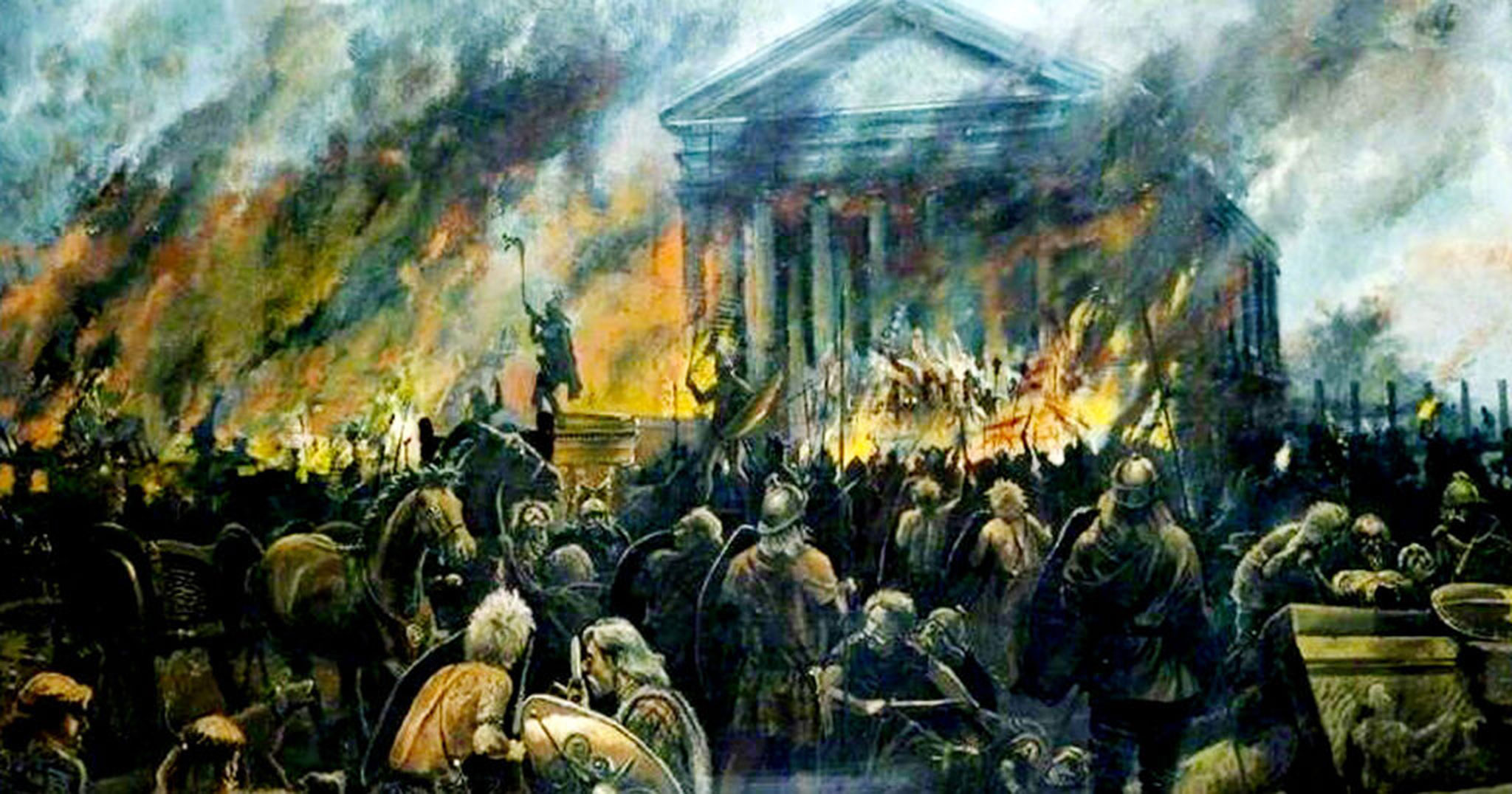
The fall of Rome, 387 ʙᴄ 
Before long those garrisoned in the Citadel could look down from the Capitoline Hill and see flames rising from the rooftops, hear the crash of houses falling in, the cries of men and the screams of women and children as they were dragged from their hiding places. After a few days of this the city was destroyed, and the Gauls set their sights on the Arx. Entreaties to surrender yielded nothing, so the Gauls gathered in the ruins of the Forum to make their typical all-out charge. This time, alerted by the Allia survivors, the Romans awaited patiently, knowing the steep going would slow the assault. And so it did. The barbarians were only halfway up the hill when the defenders plunged upon them, spearing and stabbing and sending them reeling back down. This was a bit much for the barbarians’ pride. They resolved to settle in for a siege. All the food in the city, however, had already been spirited away, eaten or burned, so raiding parties were sent out to scour the countryside and surrounding towns for provisions. In the village of Ardea, twenty-some miles south of Rome, the former dictator Camillus learned of the barbarians’ approach. “When will I be of more use to you than in war?” he told the city fathers. “It was by never knowing defeat that I held my post in my native city; in peacetime my ungrateful countrymen exiled me. Now, men of Ardea, the choice is yours.” 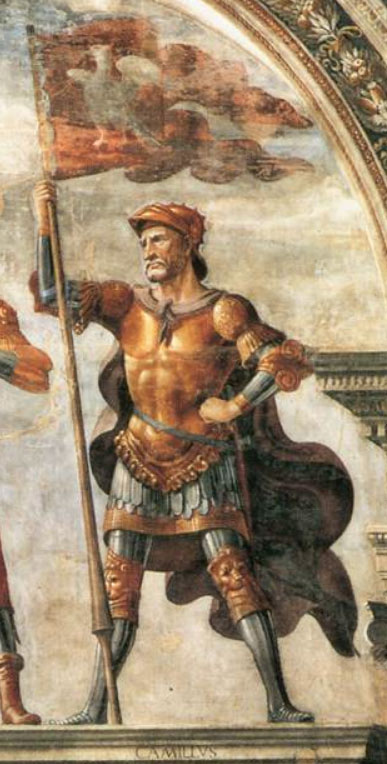
“I am a brutish champion of my country, I am a fugitive, I burn with contempt, scowls of the flames when the enemy is slain. Camillus” The Gauls, Camillus swore, were all brawn and bluster. If dealt a defeat they would run fleeing back to the Alps. Furthermore, he had a plan to do just that. The enemy foragers, fat on looted food and wine and thinking all resistance at an end, would pitch an ill-disciplined camp without defenses or sentries. “If you intend to defend your city and not allow this country to become a second Gaul,” he told the Ardeans, “take up arms, assemble the troops by the first watch and follow me not to battle, but a massacre. If I do not catch them asleep to be slaughtered like cattle, I will accept the same fate in Ardea that I met in Rome.” Sure enough, that night they found the barbarians encamped a short distance from the town, and took them by surprise. “They gave a loud shout and attacked,” wrote Livy of the Ardeans. “There was no battle, only slaughter. The Gauls, defenseless and asleep, were butchered where they lay.” “Only a few escaped in the dark,” added Plutarch, “and when day dawned, were spotted hiding in the fields, but horsemen rode them down and cut them apart.” Having thus demonstrated how to deal with barbarians, Camillus was soon begged by the Romans scattered in the nearby towns to resume his leadership. He made the most of the opportunity, refusing unless confirmed as dictator by the Senate. This presented a problem, since the Senate was still holed up in the Citadel in Rome. According to Plutarch, however, a young hero named Pontius Cominius agreed to sneak through the defenders to make contact. Swimming the Tiber at night, he entered the city by the double-arched Carmental Gate on the riverbank, scaled the Capitoline Hill by a little-known path and hailed the Roman sentries on the summit. (The barbarians seem to have been chronically lax when it came to posting guards. According to Livy they permitted one of the Fabians to come down from the Capitoline Hill and cross through the lines, over to the Quirinal Hill to conduct an annual sacrifice, and when he was done even let him return again.) The Senate hastily convened an emergency session, granted Camillus his dictatorial powers, and sent Cominius back the way he had come. Camillus set about raising an army said to number more than 20,000 men. Meanwhile, however, the Gauls discovered Cominius’ route up the Capitoline. Brennus summoned his warriors. “It would be a shame, after the start we have made, to fail in the end, and to give this place up as unassailable, when the enemy themselves have shown us how to take it,” he told them. “For where one man can easily climb it, there it will be just as easy for many to go one by one, even easier as they will help one another along. Every man will receive gifts and honors suitable to his valor.” So it was done. At midnight the Gauls scaled the cliff in such silence that they went unnoticed by the Roman sentries and even their dogs. A flock of geese, though, sacred to the goddess Juno – but, like the defenders, probably in a bad humor for lack of food – raised the alarm. Their honking and flapping woke the Romans, who grabbed up their weapons, rushed the cliff top and drove the Gauls tumbling back down the drop. In the morning, pinning blame for the surprise on a particular sentry, they threw him down after them. 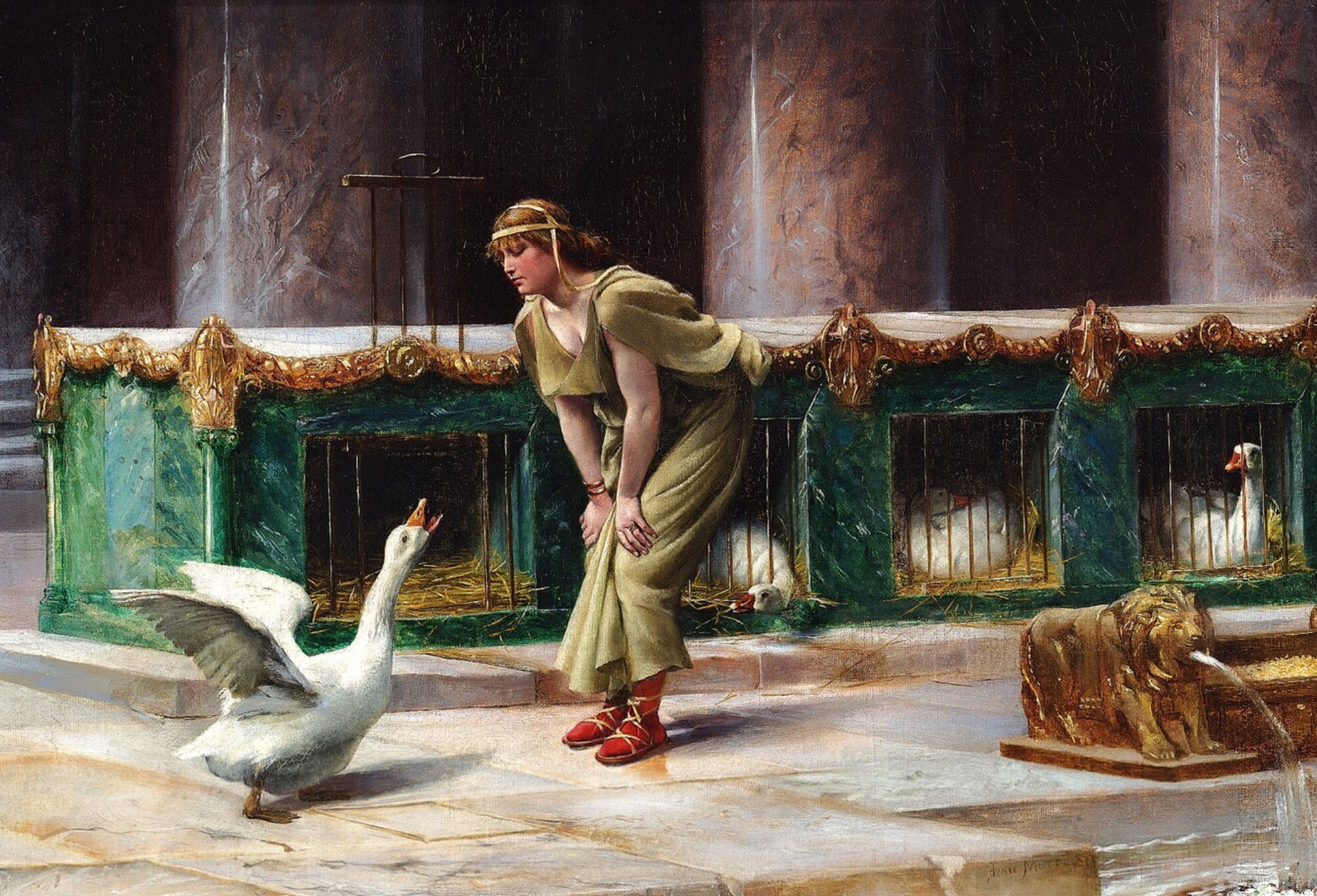
Oies sacrées du Capitole (Sacred Geese of the Capitol) by Henri-Paul Motte, 1889 
With Gaulish foraging parties subject to ambushes in the countryside, neither side was able to replenish their stores of food. The barbarians were beginning to regret having laid waste the city. Their camp, in the airless valley between the hills, was subject to drifting ash and mosquitos. Malaria, an ever-present threat in Rome, soon broke out and the Gauls – northerners, with little resistance to the disease – began dying off in such numbers that they could not be buried. The dead were piled together and burned. The site was known afterward as the Busta Gallica, the “Gaulish Crematory.” Brennus and his chieftains demanded the Romans be civilized and surrender the Citadel. They answered by tossing loaves of bread, which they could scarcely spare themselves, down the hill as a display of their provisions. Meanwhile they kept an eye out for the arrival of Camillus. He never came. It might be surmised that, as dictator, he was waiting for starvation to thin the ranks of his opponents in the Senate as much as the Gauls. Finally, Brennus hinted that the barbarians might be willing to abandon the siege in exchange for financial remuneration. “The Gauls, it is true, butchered every senator they found in the city except the Capitol, which was the only place defended,” recorded the North African theologian, philosopher and bishop, Augustine of Hippo, in the 5th century ad, “but they at least allowed those who were in the Capitol to buy their lives, even though they could easily have starved them to death if not storming it.” 
Brennus and His Share of the Spoils by Paul Jamin, 1893 The tribune Quintus Sulpicius came down to strike a bargain. To the Gauls, it turned out, Rome was worth half a ton of gold, or a little more, since the Romans accused them of cheating with heavier weights on the scales. Brennus just laughed and threw his broadsword, belt and all, on top. Sulpicius demanded, “What do you mean by this?” “Vae victis,” Brennus told him. Woe to the vanquished. 
Brennus and Camillus (in nonhistoric garb) by Tancredi Scarpelli But he spoke too soon. Likely having gotten word that the Senate was handing away the city gold, Camillus finally put in his appearance. Both Livy and Plutarch have him, with his new army backing him, striding right into the middle of the peace conference and clearing the gold off the scales. Now it was Brennus protesting that the deal was already made, to which Camillus replied that the Senate had no authority to bargain anything without his approval as dictator: “Non auro, sed ferro, recuperanda est patria.” Not with gold, but iron, is the country to be saved. There followed what Livy described as something of a battle, but Plutarch as more of a shoving match, there being no room amid the ruins for either side to assume any kind of fighting formation. In this contest the disease-weakened Gauls came off second best, and Brennus took his people away, to camp about ten miles east at the village of Gabii, on the shore of an extinct volcano’s crater lake. The next morning Camillus fell on them there. “Here the slaughter was complete,” proclaimed Livy, “the camp was taken, and not a single man survived to carry word of the catastrophe.” 
Marcus Furius Camillus defeating the Gauls by Mariano Rossi. “Of those who escaped,” says Plutarch, “some were immediately chased and cut down, but most of them scattered, only to be set upon and killed by the people of the local villages and towns.” Nothing more is heard of Brennus. It's presumed he was killed with the rest. The Senones would battle Rome on and off for another century, even making common cause with the Etruscans, until finally defeated at Lake Vadimo in 283 ʙᴄ. The memory of them, however, left its mark on the Roman psyche. Almost 800 years after the sack, the Roman priest, theologian, and historian Jerome of Stridon wrote: In the old days the Roman Empire was tainted with shame forever because after laying waste the country and defeating the Romans at the Allia, Brennus and his Gauls entered Rome itself. Nor could this ancient blemish be wiped clean until Gaul, the birthplace of the Gauls, and Gaulish Greece, where they settled after vanquishing East and West, were mastered. That was all in the future. For the time being Marcus Furius Camillus was the hero of the day. On his return to the city he was hailed as another Romulus, another founder of Rome, and like him titled by senatorial edict pater patriae, the father of the country. Though many plebeians argued to abandon the ruins of the city, Camillus ordered it rebuilt. He saw to the reinforcing of the original Servian Wall, almost seven miles around, with blocks of volcanic stone, in places thirty feet high and twelve feet thick. Revising Roman arms, armor, and tactics to better deal with the barbarians’ heavy swords, it was Camillus who did away with the Greek-style phalanx and shield wall for the legio, the levy of cohorts and centuries, with cavalry, light infantry, and heavy infantry. He went on to defend Rome against the Etruscans, southern Latins, and more Gauls. He held the office of consular tribune and served as dictator five times until his death of plague in 365 ʙᴄ, the longest effective one-man rule of Rome for some 280 years. The lesson was clear. In times of war, a military strongman was necessary to face down threats from outside. Placating foreign interlopers was the road to ruin. But over the ensuing centuries the Romans forgot the admonition of Brennus. Vae victis. Woe to the vanquished. REVIEWS:
After reading this book, the fall of Rome feels less like revenge, even less like a tragedy, and more like a moment of justice. It is a multi-faceted story about empire, humanity’s basest instincts, and how the motives of the powerful often lead to the suffering of the weak. For those who love the subject of Ancient Rome, this book is a must-read. For everyone else, I would find it hard to not call this a must-read. It is a fascinating story written by a great storyteller.
In less assured hands, this could have been a turgid and thoroughly bewildering read. Thankfully, Don Hollway knows his subject inside out and neatly picks his way through the convoluted history of the late Roman Empire.... Hollway eloquently describes a treacherous, fragile world, in which the greatest empire the world has ever seen slowly collapsed under its own weight.... Overall, I very much enjoyed this excellent study of the fall of a centuries-old empire, scholarly but never dull. Thoroughly recommended. To say I thoroughly enjoyed reading this book would be an understatement. Well written, witty, and very informative, it reads like a novel, yet is non-fiction. It strikes a good balance between too academic and flippant, covering off all the relevant history at a good pace, not getting bogged down in excessive detail; I’d read several chapters in a sitting, with a single malt or coffee as company. Very recommended to persons interested in ancient Rome, or those who would like a good read. A gifted storyteller, Hollway wraps his narrative around the lives of two men prominent within the maelstrom of intrigue and war: Flavius Stilicho, the supreme military commander of Rome, and Alaric, king of the Goths.... Whether describing battles or political plots, Hollway has a knack for breathing life into history. At the Gates of Rome is a solid work of scholarship as well as a good read. Fans of Hollway’s short work already know his outstanding narrative style is matched by his impressive range. Coming on the heels of his medieval masterpiece The Last Viking, At the Gates of Rome brings Hollway’s marriage of thrilling storytelling and historical rigor to Late Antiquity. In this illuminating page-turner, Hollway walks us through the fate of one of the most significant civilizations in human history. There are works of history we return to as reference, and those we return to as inspiration. In At the Gates of Rome, Hollway has given us both. Don Hollway’s At the Gates of Rome is a masterful blending of solid scholarship and excellent storytelling that brings the Eternal City’s turbulent early history to vibrant life. Patricians and barbarians, slaves and saints, victors and vanquished leap from the pages fully formed, making the book an enthralling read from the first page to the last. The author uses the descriptions of ancient writers and more recent histories to create this account of the Western Empire’s final years. A wide range of figures are included, giving depth and detail to the narrative and revealing the vast scale of the Roman Empire and its adversaries. With so much of the writing on the Late Roman Empire dated, it is refreshing to read a work that offers a fresh interpretation of the events. ORDER TODAY: 

• AMAZON • PUBLICITY CONTACTS: REPRESENTATION Scott Mendel, Managing Partner About the author
Author/historian/illustrator Don Hollway has been published in Aviation History, Excellence, History Magazine, Military Heritage, Military History, Civil War Quarterly, Muzzleloader, Porsche Panorama, Renaissance Magazine, Scientific American, Vietnam, Wild West, and World War II magazines. His first book, The Last Viking, a gripping history of King Harald Hardrada, was acclaimed by The Times of London and Michael Dirda, Pulitzer Prize-winning critic for the Washington Post. Hollway is also a classical rapier fencer and historical re-enactor. His work is also available across the internet, a number of his pages scoring extremely high in global search rankings.
More from Don Hollway:Comments loading....
© 2022 Donald A. Hollway |
